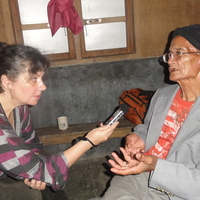Papers by Md Rahat Hossain
Canadian Medical Association Journal
Intérêts concurrents : Aucun intérêt concurrent déclaré. Cet article a été révisé par des pairs.
Psychotherapies and digital interventions for OCD in adults: What do we know, what do we need still to explore?
Comprehensive Psychiatry
Characterizing the content, messaging, and tone of trichotillomania on YouTube: A content analysis
Journal of Psychiatric Research

Medical Care
Background: Intervention studies with vulnerable groups in the emergency department (ED) suffer f... more Background: Intervention studies with vulnerable groups in the emergency department (ED) suffer from lower quality and an absence of administrative health data. We used administrative health data to identify and describe people experiencing homelessness who access EDs, characterize patterns of ED use relative to the general population, and apply findings to inform the design of a peer support program. Methods: We conducted a serial cross-sectional study using administrative health data to examine ED use by people experiencing homelessness and nonhomeless individuals in the Niagara region of Ontario, Canada from April 1, 2010 to March 31, 2018. Outcomes included number of visits; unique patients; group proportions of Canadian Triage and Acuity Scale (CTAS) scores; time spent in emergency; and time to see an MD. Descriptive statistics were generated with t tests for point estimates and a Mann-Whitney U test for distributional measures. Results: We included 1,486,699 ED visits. The num...

With nearly half of the world’s population living in the cities, many city and local governments ... more With nearly half of the world’s population living in the cities, many city and local governments are seeking to deploy smart solutions to their everyday city operations through the implementation of smart city services. However, the subject of smart city services has always been associated with trustworthiness of the services by its users due to security and privacy concerns. These issues may have a major impact on the smart city services adoption. The aim of this proposed research is to examine the technology, organisational, environment, and security determinants that influence stakeholders’ trust towards their intention to adopt smart city services in Australian regional cities. For this, Technology-OrganisationEnvironment framework together with security related factors for ensuring stakeholders’ trust will be tested using both quantitative and qualitative data. Structural equation modelling technique will be carried out using Smart PLS to test the presented hypotheses and the r...

Characterizing people experiencing homelessness and trends in homelessness using population-level emergency department visit data in Ontario, Canada
Health reports, 2021
BACKGROUND Data on people experiencing homelessness often come from time- and labour-intensive cr... more BACKGROUND Data on people experiencing homelessness often come from time- and labour-intensive cross-sectional counts and surveys from selected samples. This study uses comprehensive administrative health data from emergency department (ED) visits to enumerate people experiencing homelessness and characterize demographic and geographic trends in the province of Ontario, Canada, from 2010 to 2017. DATA AND METHODS People experiencing homelessness were identified by their postal code, designated as "XX." Outcomes included the number of people experiencing homelessness stratified by year and week, gender and age plotted annually, the location of each ED visit, and composition changes in demographics and geographic distribution. RESULTS Over seven years, 39,408 individuals were identified as experiencing homelessness. The number of ED visits increased over the study period in all of Ontario. The average peak in the number of visits occurred annually in September, with the fewe...

The NHS Health Check is a national screening programme targeting cardiovascular disease (CVD), th... more The NHS Health Check is a national screening programme targeting cardiovascular disease (CVD), the leading cause of death in the UK. Effectiveness of the NHS Health Check is still under evaluation and no randomised controlled trial (RCT) has been undertaken to date. Current research results are largely inconclusive. Initially low, programme uptake has been increasing in recent years, reaching nationally up to half of the eligible population. While the research data gives a mixed picture, concerns have been raised about differential uptake among different demographic groups, including those living in more deprived areas. Area deprivation is known to correlate with higher CVD risk. Public Health England, among other bodies, have called for further research into the impact and coverage of NHS Health Checks. The ‘Health MOT Roadshow’ is a community-based health check programme consisting of outreach, referrals, and on-site Health MOTs as well as NHS Health Check. It is delivered by Well...

The Australasian Journal of Regional Studies, 2017
Periodic housing unaffordability in Australian resource-led regional cities has been continuing o... more Periodic housing unaffordability in Australian resource-led regional cities has been continuing over the last two decades, creating pressures on the economic and social life of individuals to communities. This paper examines the perceived household risks to housing unaffordability in resource-led regional communities through a case study of Rockhampton and Gladstone cities in Queensland, Australia. Two hundred households were surveyed from these two cities and a probability based consensus and agreement method was then used to analyse the risks that the community perceived to exist due to housing unaffordability. The study found that economic and social risks and stresses such as extra pressures on household budgets, long commuting time, and difficulty with children's schooling, moving away from friends and relatives and poor health were the most common perceived risks in these two communities. The result of chi-square tests confirmed that perceived risks of housing unaffordabil...
Uncovering the Lived Experience of Homelessness: Conducting Interviews and Generating Themes to Understand Barriers and Facilitators to Care Through Qualitative Descriptive Research

CJEM, 2020
Introduction: Despite the visibility of the homeless population, there is limited data on the inf... more Introduction: Despite the visibility of the homeless population, there is limited data on the information of this patient population. Point-in-time counts and survey data from selected samples (such as those admitted to emergency shelter) have primarily been used. This literature suggests that this hard-to-reach population has high rates of presentation at emergency departments (EDs), and as such, EDs often become their main point of contact for health and social services. Leveraging this fact and administrative data we construct a crude census of homeless persons within Ontario. We further examine demographic characteristics of patients experiencing homelessness, and compare this data to findings from previous literature. Methods: All routinely collected administrative health data from EDs located within Ontario, Canada from 2010-2017 were analyzed to examine patient characteristics. Individuals experiencing homelessness were identified by a marker that was adopted in 2009 replacin...

CJEM, 2020
Introduction: Understanding how homeless patients interact with healthcare systems can be challen... more Introduction: Understanding how homeless patients interact with healthcare systems can be challenging. The nature of the population is such that identifying and following these persons can be severely limited by data. Previous studies have used survey data which relies on self-reporting and selected samples such as those persons admitted to homeless shelters (Gray et al. 2011). Other studies have been able to leverage administrative data but only for selected local geographic areas (Somers et al. 2016, Tompkins et al 2003). It is possible that the current literature has not examined a large proportion of homeless persons and their healthcare use. This is concerning because this population can have higher associated medical costs and greater medical resource utilization especially with regards to psychiatric and emergency department (ED) resources (Tulloch et al. 2012, Forchuk et al, 2015). Methods: Administrative health data (2010 to 2017) is used to analyze ambulatory care records ...

CJEM, 2020
Introduction: Administrative data can aid in study and intervention design, incorporating hard-to... more Introduction: Administrative data can aid in study and intervention design, incorporating hard-to-reach individuals who may otherwise be poorly represented. We aim to use administrative health data to examine emergency department visits by people experiencing homelessness and explore the application of this data for planning interventions. Methods: We conducted a serial cross-sectional study examining emergency department use by people experiencing homelessness and non-homeless individuals in the Niagara region of Ontario, Canada. The study period included administrative health data from April 1st, 2010 to March 31st, 2018. Outcomes included number of visits, number of unique patients; group proportions of Canadian Triage and Acuity Scale (CTAS) scores; time spent in emergency; and time to see an MD. Descriptive statistics were generated, and t-tests were performed for point estimates and a Mann-Whitney U test for distributional measures. Results: Our data included 1,486,699 emergen...

CJEM, 2020
Introduction: People experiencing homelessness have complex psychiatric and medical presentations... more Introduction: People experiencing homelessness have complex psychiatric and medical presentations, and have poor access to primary care. Thus, emergency departments (EDs) often become their main point of healthcare contact. Using routinely collected administrative data from EDs, we examine the ED utilization, health and reasons for presentations of people experiencing homelessness.. Methods: All routinely collected administrative health data from EDs located within Ontario, Canada from 2010-2017 were analyzed. Individuals experiencing homelessness were identified by a marker that was adopted in 2009 replacing their recorded postal code with an XX designation. Outcomes include number of unique patients, number of visits and repeat visits, CTAS scores, ambulance utilization, and type of ICD-10 presentation. Results: 640,897 visits to the ED over 10 years were made by 39,525 unique individuals experiencing homelessness. A visit to an ED by a homeless patient resulted in repeat presenta...

Canadian Medical Education Journal, 2018
Background: Regional medical campuses are often located in geographic regions that have different... more Background: Regional medical campuses are often located in geographic regions that have different populations than the main campus, and are well-positioned to advocate for the health needs of their local community to promote social accountability within the medical school.Methods: At the Niagara Regional Campus of McMaster University, medical students developed a framework which combined research, advocacy, and theatre to advocate for the needs of the local population of the regional campus to which they were assigned. This involved a qualitative study using semi-structured interviews with homeless individuals to explore their experience accessing the healthcare system and using a transformative framework to identify barriers to receiving quality healthcare services. Findings from the qualitative study informed a play script that presented the experiences of homeless individuals in the local health system, which was presented to health sciences learners and practicing health profess...

Bangladesh Journal of Zoology, 2019
A cross sectional study was carried out among school going children of Ganaktuli slum area in Dha... more A cross sectional study was carried out among school going children of Ganaktuli slum area in Dhaka city, Bangladesh. A total of 183 stool samples were collected from children of age between 5 and 16 years of both sexes during May, 2017 to April, 2018. Collected samples were examined using Formal-Ether Concentration technique. 61.20% samples were found positive for intestinal parasites. Eight species of parasites were identified, where Entamoeba histolytica (3.83%), Giardia lamblia (6.01%), Diphyllobothrium latum (3.28%), Paragonimus westermani (3.83%), Ascaris lumbricoides (24.59%), Trichuris trichiura (12.02%), Ancylostoma duodenale (5.46%) and Enterobius vermicularis (2.19%) was recorded. Male children showed higher (63.95%) prevalence than female (58.76%). The highest and lowest prevalence (82.46 and 39.29%) were found among 8 - 10 and 14 - 16 years children, respectively. The highest prevalence of E. histolytica (7.02%), A. lumbricoides (38.60%), T. trichiura (14.04%) and A. du...

Qualitative Health Research, 2019
Persons struggling with housing remain significantly disadvantaged when considering access to hea... more Persons struggling with housing remain significantly disadvantaged when considering access to health care. Effective advocacy for their needs will require understanding the factors which impact their health care, and which of those most concern patients themselves. A qualitative descriptive study through the lens of a transformative framework was used to identify barriers and facilitators to accessing health care as perceived by people experiencing homelessness in the regional municipality of Niagara, Canada. In-person, semi-structured interviews with 16 participants were completed, and inductive thematic analysis identified nine barriers and eight facilitators. Barriers included affordability, challenges finding primary care, inadequacy of the psychiatric model, inappropriate management, lack of trust in health care providers, poor therapeutic relationships, systemic issues, and transportation and accessibility. Facilitators included accessibility of services, community health care...
Solar power estimation: a hybrid prediction method using computational intelligence
Renewable Energy, 2013

Flood in blood: Assessing housing market vulnerability within the Fitzroy Basin region, Australia
Regional communities in Queensland, Australia are the life-blood of the state; contributing more ... more Regional communities in Queensland, Australia are the life-blood of the state; contributing more than 80% of exports goods and services, as well as about 16 billion dollars each year to the state’s economy. Weather-related disasters such as floods have become more frequent over the last fifty years in those communities. Between December 2010 and January 2011, three-quarters of the state was declared as disaster zone as a result of flooding. At least seventy towns and over 200,000 people were affected by these floods. The Fitzroy Basin is the largest coastal catchment in Queensland and the second largest catchment in Australia; and the most towns in this basin have been affected by this flood. This study examined the vulnerability of the housing market through a case study of Rockhampton region within this basin by using longitudinal data of total house sales, new house and land package sales, land sales before and after the 2011 flood and also tested the results with a key regional economic factor (mining development) whether the flood impact has been relieved by this factor. This study found that the flood has affected the total house sales compared to new house and land sales and land only sales; and also flood impact has relatively relieved by mining impact.










Uploads
Papers by Md Rahat Hossain